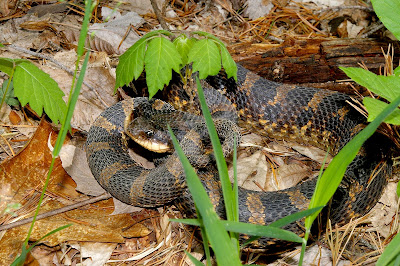I have always been fascinated with creepy crawlies. I would eagerly devour the last pickle, or watch patiently as the last scoop of coffee was placed in the percolator, so I could beg my mother for the empty containers. Then I would methodically poke the lids full of holes and place my six-legged friends inside. I would carefully select a variety of soft leaves and grasses to line their new home. And, on a recent nature walk, it is obvious this childhood passion has not disappeared. I am still excited to see a cool bug! (Yes, entomologist types, I know that technically "bug" is not the correct term to use and that a true bug is in the order Hemiptera, so spare the comments.)
One of the coolest insects out there is the Water Scorpion ( Ranatra fusca). We caught a few during a recent pond exploration with our Habitats program. This amazing creature looks just like a reed or bulrush in the water. It will cling to vegetation with its four back legs and will hold its forelimbs directly in front. When an unsuspecting victim wanders nearby, the water scorpion will use the back pair of legs to shoot out and "BAM", just like Emeril, the prey is tight in the clutches of the water scorpion, soon to be devoured in a most gruesome fashion.
The water scorpion is a true bug, in the order Hemiptera. All true bugs have a long straight sucking mouthpart called a stylet. The stylet is usually found tucked undeneath and along the bug's abdomen. The stylet has two canals with one used to deliver enzymes that digest plant or animal material, depending on the bug and its choice of food. The other canal is used like a straw to suck up the digested material. Water scorpions will jab this stylet into their victim like a hypodermic needle. They deliver the digestive enzymes into the victims body, then slurp up the meal like a milkshake. Bug juice milkshake-Mmmmm!

Water Scorpion-check out the grasping forelimbs
Another very cool feature about this bug is it has a long ominous-looking appendage on its posterior end that resembles a stinger. This is actually a breathing tube made of two side by side filaments. The water scorpion will actually carry a submerged air bubble that will serve as a renewable air supply. The air is trapped by tiny hair-like structures on the forewings and abdomen of the insect. The breathing tube can replenish the oxygen supply to this air bubble from the surface or from dissolved oxygen from nearby vegetation. This allows the water scorpion to sit submerged for long periods of time, motionless, while in wait of prey. So basically, the water scorpion has a built in snorkel. You can also say it can breathe out of its butt!

Look at how well this guy is camouflaged! The coloration is perfect and if one was not looking for it, they could easily pass it by. What an amazing creature!


 I found this salamander scrambling over the forest floor. It looked like it was on a mission. And I found out that it really was. Red-spotted Newts have a three stage life-cycle. The first stage is an aquatic larval stage, where it has gills. Next is the red eft, a terrestrial stage which is responsible for dispersing the population and widening the gene pool. It explores new ponds and thereby insures survival and health of the population. If these salamanders were just to stay in one little pond and something happened, say a large predator or a pollution incident, the whole population could be wiped out. So, journeying out and finding new ponds is an important mission for the salamander. The last stage is also aquatic, the Red-spotted Newt adult. This stage of the salamander is olive green with red spots. It also has a laterally compressed tail, which means it is flattened on the sides, to aid in swimming.
I found this salamander scrambling over the forest floor. It looked like it was on a mission. And I found out that it really was. Red-spotted Newts have a three stage life-cycle. The first stage is an aquatic larval stage, where it has gills. Next is the red eft, a terrestrial stage which is responsible for dispersing the population and widening the gene pool. It explores new ponds and thereby insures survival and health of the population. If these salamanders were just to stay in one little pond and something happened, say a large predator or a pollution incident, the whole population could be wiped out. So, journeying out and finding new ponds is an important mission for the salamander. The last stage is also aquatic, the Red-spotted Newt adult. This stage of the salamander is olive green with red spots. It also has a laterally compressed tail, which means it is flattened on the sides, to aid in swimming.







